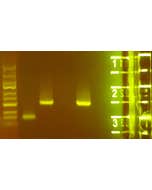Kit for detecting GMOs by PCR amplification
Topics covered:
- Highlighting the existence of numerous transgenic plants in nature (GMOs)
- Conducting a complete molecular biology experiment: extraction, purification, PCR amplification and gel electrophoresis, analysis of DNA sequences
Principles and objectives:
To create GMOs in the laboratory (insertion of exogenous DNA sequences into a target genome), scientists use the gene vector technique based on the ability of certain bacteria like agrobacterium to transfer genetic material. This process in vitro replicates a phenomenon that frequently occurs in nature. In 2019, researchers from IBMP highlighted the existence of numerous transgenic plants in nature and that this phenomenon had been more common during plant evolution.
This practical work aims to detect the presence or absence of an agrobacterium gene by PCR in the genome of peanuts, a naturally inherited DNA sequence. This presence indicates a horizontal genetic transfer that occurred during evolution. The experiment will be complemented by sequence analysis using a genetics software.
This kit is designed for 20 pairs. It requires 2 sessions of 60 minutes each.
PCR microtubes, primers, ready-to-use PCR reagents, raw peanut samples, molecular weight ladder, pack of 10 precast 2% EasyGreen™ Agarose gels, 200 ml of 10X TAE.
| Thématique TP | Biologie |










